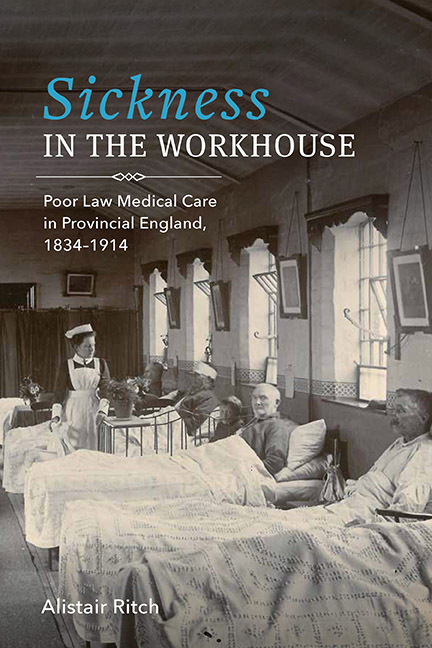Book contents
- Frontmatter
- Dedication
- Contents
- List of Tables
- Acknowledgments
- Introduction: Pauperism and Sickness
- 1 From Acute Illness to Chronic Disability
- 2 Segregating Fever Patients
- 3 Controlling Disorderly Behavior
- 4 Day-to-day Doctoring
- 5 Medical Therapies
- 6 Poor Law Nursing
- 7 “Every Care and Kindness”: The Standard of Workhouse Medicine
- Appendix A Prevalence of Selected Infectious Diseases in Birmingham Workhouse on the Last Day of the First Week of Each Quarter for the Years 1877–80 and 1894–1911
- Appendix B Medical Relief in Birmingham Workhouse for Selected Weeks, 1851–56
- Appendix C List of Drugs Kept in the Wards of Birmingham Infirmary in 1896
- Appendix D Pauperism Rates and Institutionalization Rates for Birmingham Parish, Wolverhampton Union, and England and Wales, 1840–1911
- Notes
- Bibliography
- Index
- Frontmatter
- Dedication
- Contents
- List of Tables
- Acknowledgments
- Introduction: Pauperism and Sickness
- 1 From Acute Illness to Chronic Disability
- 2 Segregating Fever Patients
- 3 Controlling Disorderly Behavior
- 4 Day-to-day Doctoring
- 5 Medical Therapies
- 6 Poor Law Nursing
- 7 “Every Care and Kindness”: The Standard of Workhouse Medicine
- Appendix A Prevalence of Selected Infectious Diseases in Birmingham Workhouse on the Last Day of the First Week of Each Quarter for the Years 1877–80 and 1894–1911
- Appendix B Medical Relief in Birmingham Workhouse for Selected Weeks, 1851–56
- Appendix C List of Drugs Kept in the Wards of Birmingham Infirmary in 1896
- Appendix D Pauperism Rates and Institutionalization Rates for Birmingham Parish, Wolverhampton Union, and England and Wales, 1840–1911
- Notes
- Bibliography
- Index
Summary
The dominance of the Nightingale reforms in the history of nursing has overshadowed improvements within poor law nursing. Indeed, studies of nursing within poor law institutions have been sparse, possibly because of the uncertainty surrounding the nature of those carrying out nursing duties. Accounts included in general studies of nursing history have concentrated on the improvement in conditions of service and the increasing involvement of poor law nurses with acutely ill patients. Christopher Maggs describes nurse recruitment in the late nineteenth century in one voluntary hospital and three poor law infirmaries and notes that the most significant quantitative change over the period was the rapid expansion in the number of nurses in the poor law sector. In a general text on the history of nursing, the poor law sector receives minimal attention, even in the section on midwifery, although the majority of births in institutions took place in the workhouse. For instance, 1 percent of the 1.3 percent of births in institutions in 1890 is estimated to have taken place in workhouses. Rosemary White has provided the one dedicated account of poor law nurses, in which she points out that, despite the lack of interest by historians and the nursing profession, they nursed 75 percent of all hospital patients. Moreover, the nature of the nursing tasks they performed and their interaction with the patients they cared for has been relatively neglected. White has been praised for doing much to rehabilitate the image of the poor law nursing service by showing that its members often achieved relatively high standards of nursing care. Their status was on par with those trained in voluntary hospitals as a substantial number of poor law probationers have been shown to find employment in the voluntary hospital sector. Although Brian Abel-Smith and Anne Dig by contend that nursing staff disliked the tedium of caring for the chronic sick, Rosemary White maintains that poor law nurses developed expertise in the nursing care of those with chronic illnesses and incurable diseases and played a major part in retaining the caring role within nursing.
The historiography of the nursing profession prior to 1980 has been written for the most part as a conventional, congratulatory discourse and only since the late 1980s has it developed into a more critical and reflective area of scholarship.
- Type
- Chapter
- Information
- Sickness in the WorkhousePoor Law Medical Care in Provincial England, 1834–1914, pp. 187 - 219Publisher: Boydell & BrewerPrint publication year: 2019

